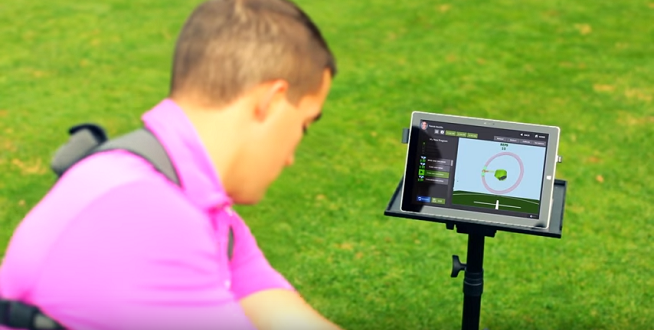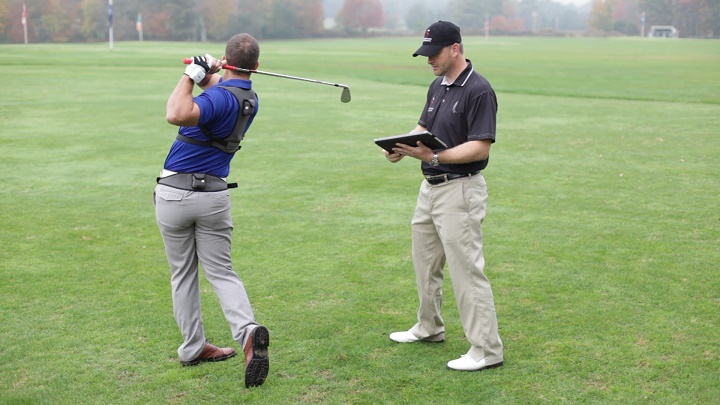by Tim Suzor
As a PGA Teaching Professional for 20+ years, I hear this most often at the beginning of every lesson:
“Tim… if I could just be more consistent, I’d play great.”
Let’s take a look at that word–consistency. Are we in fact perhaps more consistent than we think? The truth is, when we observe players with the naked eye or collect high-speed video and 3D data on them, we often see very consistent patterns that are completely opposite of what they experience on the golf course.
The reason why the data is relatively consistent is that golfers have repeated certain motion thousands and thousands of times.
Q: “But if our data is so consistent, why do the outcomes vary so much?”
A: “Inefficient patterns and all the fundamental variables in the swing make timing is difficult to repeat, especially if the golfing environment shifts as well.”
The term “neurological governing” was coined to reflect how the body is forced to move due to gait patterns, mobility, stability, and strength. For example, if players have limited rotational mobility in the spine, they will be forced to use another segment of the body (e.g., the feet or pelvis) to generate speed.

Also, the mind has to be consistent with the shot routine and the set of instructions it’s giving the body. The human brain is firing billions of bits of information, but we’re aware of only a few thousand at any given time. These are concerned with our body, our environment, and time.The oldest part of our brain, often referred to as “the reptilian brain,” has the most neuronal connections. This is the seat of your subconscious, and it very powerful when it comes to performing under pressure.
The goal in learning any motor skill is for it to be automatic when our conscious mind gives our body a set of instructions. Our conscious mind makes the strategic decisions such as those dealing with club selection, lie, wind, and target. Once we have set an intention, the body executes the motor program that it has been conditioned to repeat.
Whether you’re learning to play a musical instrument, riding a bike or driving a car repetition is the key to performance. The human brain is electrical and chemical. The part of the brain that deals with your emotions is the midbrain and the executive to the brain is the thinking Neo‐Cortex.
So if you want to learn a skills such as golf the mind needs to go from Thinking (Neo‐Cortex) to repetition until it is part of our being (Sub‐Conscious). Just think of some of the things we do that are automated every day like tying our shoes, brushing our teeth, or driving a car.
Q: “How does a golfer develop the skill, in an efficient manner, to call up a desired shot at any given time?”
A: “Repetition–forging the motion in your subconscious, so it can be repeated over and over, even under abnormal conditions such as ‘on-course pressure.’”
Q: “If golfers are on the range hitting balls, aren’t they performing helpful repetitions?”
A: “One could argue that they are not in the act of repeating because their practice motions aren’t consistent.”
One way to address this nonoptimal version of repetition is by using biofeedback. Biofeedback offers the player an ability to practice — in other words, to repeat a motion over and over — in perfect sequence and in perfect position.

When working with some of the best players in the world, I always hear, “I’m a feel-player.” That’s what biofeedback does: it provides us with feel. Feel is the most important of the five senses when it comes to athletic performance.
What biofeedback enables, especially in the context of K-VEST, is the ability to make sure that each repetition is performed exactly like the last correct one. When a player’s biomechanical numbers are in range, then the player is made aware of this, and the motion counts.
Yet it’s important when using biofeedback, or any kind of training aid that governs movement, that we filter in repetitions done without guidance. Why? Because ultimately the mind and body need to internalize what is feel and what is real.
I often have my players do a specific ratio of repetitions with and without biofeedback, so that the mind and body can get in sync. Biofeedback is a powerful tool, but of course it’s not available outside of practice, so coaches need to bear in mind that players can’t come to depend on it. In short, it’s a practice resource, not a playing resource.
Q: “Coach Suzor, I’ve heard that I need to determine if I’m a visual, kinesthetic, or auditory learner. Is that true?”
A: “Yes and no. We play our best golf when we slow down our analytical mind and move into the performance state, which draws upon a combination of feeling and visualizing.”
Ideally, then, biofeedback operates in a multimodal fashion. Knowing your personal learning style can be beneficial, but biofeedback used in conjunction with topflight coaching should naturally accommodate a range of such styles. The most important thing to keep in mind is the simple principle that to improve movement patterns in any part of your game, from a 3’ putt to a full-swing driver, you should practice efficiently.
This is why biofeedback training is such an effective instructional tool. It takes the guesswork entirely out of the equation. There are no more questions of, “Am I doing this drill correctly?” Instead, the drill is learned without trial and error, and repeated again and again with minimum deviation. In a word… consistency.
 Tim Suzor is a Class A PGA Golf Professional trained and certified across a wide spectrum of mental and physical disciplines. His ability to improve a player’s total golf performance is due, in large part, to his knowledge of biomechanics, neuroscience, 3D-motion analysis, club fitting and fitness training. Voted one of America’s Top Instructors, Tim’s players have won at every level including College DI, LPGA and PGA Tour. He co-founded Kinetic Golf 360, an indoor performance center designed to integrate all aspects of golf including instruction, club fitting, fitness, physical therapy, and mental performance. Tim has been with K-VEST since inception as both a certification director and Director of Business Development. He now serves as CEO of THINQ Sports, an online company that coaches all aspects of the mental game. Tim graduated from Ferris State University with a Bachelor of Arts in Marketing and an emphasis on Professional Golf Management.
Tim Suzor is a Class A PGA Golf Professional trained and certified across a wide spectrum of mental and physical disciplines. His ability to improve a player’s total golf performance is due, in large part, to his knowledge of biomechanics, neuroscience, 3D-motion analysis, club fitting and fitness training. Voted one of America’s Top Instructors, Tim’s players have won at every level including College DI, LPGA and PGA Tour. He co-founded Kinetic Golf 360, an indoor performance center designed to integrate all aspects of golf including instruction, club fitting, fitness, physical therapy, and mental performance. Tim has been with K-VEST since inception as both a certification director and Director of Business Development. He now serves as CEO of THINQ Sports, an online company that coaches all aspects of the mental game. Tim graduated from Ferris State University with a Bachelor of Arts in Marketing and an emphasis on Professional Golf Management.
The MLB Winter Meetings brings together baseball executives, coaches, media, exhibitors and job seekers from around the world to network, fill job openings, attend educational workshops and discuss innovating trends in the industry. It’s one of the highlights of our…
Agreement to Accelerate Improvement Across All Levels of the Organization (SCOTTSDALE, Ariz.) K-MOTION – the leader in 3D evaluations and biofeedback training solutions for coaches and athletes – announces an agreement with the Baltimore Orioles to become the organization’s Player…
By Joe DiChiara and Jason Meisch You take a swing and don’t like where the golf ball goes. You want to know what happened, so you turn to your launch monitor. You look at the club face numbers. They tell…